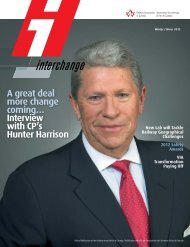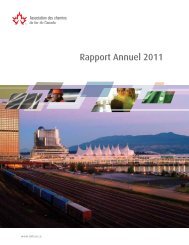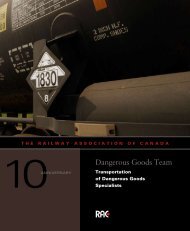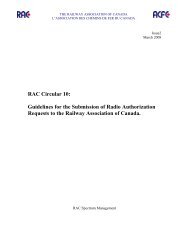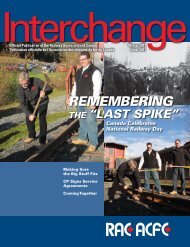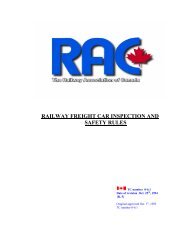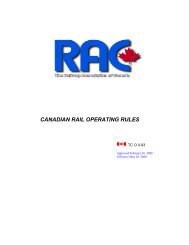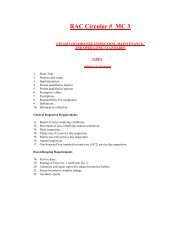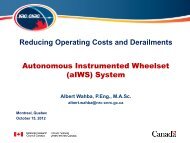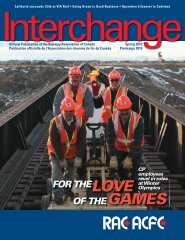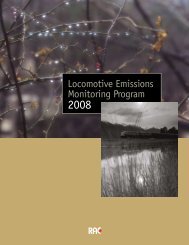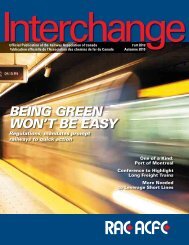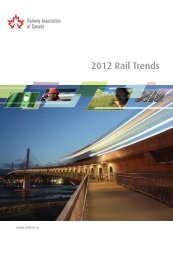TC O-112: Railway Locomotive Inspection and Safety Rules (pdf ...
TC O-112: Railway Locomotive Inspection and Safety Rules (pdf ...
TC O-112: Railway Locomotive Inspection and Safety Rules (pdf ...
You also want an ePaper? Increase the reach of your titles
YUMPU automatically turns print PDFs into web optimized ePapers that Google loves.
RAILWAY LOCOMOTIVEINSPECTION AND SAFETYRULES<strong>TC</strong> O -<strong>112</strong>Approved September 18, 1997Revised February 4, 2010
RAILWAY LOCOMOTIVEINSPECTION AND SAFETY RULESPART I - GENERALCONTENTS1. Short Title2. Scope3. Definitions4. <strong>Railway</strong> Company Responsibility5. Application of <strong>Safety</strong> <strong>Inspection</strong>s <strong>and</strong> Movement Restrictions6. Certified <strong>Locomotive</strong> Inspector7. <strong>Safety</strong> <strong>Inspection</strong> Locations8. Pre-Departure <strong>Inspection</strong>9. Captive ServicePART II - LOCOMOTIVE DESIGN REQUIREMENTS10. General Design11. Audible Signals12. Event Recorders13. <strong>Safety</strong> Control Equipment14. <strong>Safety</strong> Appliances15. Spark Arresting Devices16. Illuminating Devices17. <strong>Safety</strong> Glazing18. Fail Safe Circuits <strong>and</strong> Systems19. Fuel Tanks20. Wheels <strong>and</strong> AxlesPART III - LOCOMOTIVE INSPECTION REQUIREMENTS21. Brake System22. Trucks23. Wheels <strong>and</strong> Axles24. Draft Systems25. Fuel Tanks26. Internal Combustion Engines27. Rail Clearance28. Windows29. <strong>Safety</strong> Control Equipment30. <strong>Safety</strong> Appliances31. Speed Indicators32. Event Recorders2
33. Audible Signals34. Illuminating DevicesPART IV - LOCOMOTIVE FILING REQUIREMENTS35. Filing Requirements with the Department36. ExceptionPART V - STEAM LOCOMOTIVES37. Steam <strong>Locomotive</strong>sAPPENDIX I - Pre-Departure <strong>Inspection</strong> by a <strong>Locomotive</strong> Operator or Other QualifiedPersonAPPENDIX II - <strong>Locomotive</strong> Specifications3
PART I - GENERAL1. SHORT TITLE1.1 For ease of reference, these rules may be referred to as the “<strong>Locomotive</strong> <strong>Safety</strong> <strong>Rules</strong>”2. SCOPE2.1 These rules prescribe the minimum safety st<strong>and</strong>ards for locomotives operated by railwaycompanies subject to the jurisdiction of Transport Canada pursuant to the <strong>Railway</strong> <strong>Safety</strong>Act.3. DEFINITIONSIn these rules:3.1 a) “bad order” means a locomotive having a defect as defined in Part III of these rules;b) “bad order information system” means any method, computerized or otherwise, bywhich a railway company controls <strong>and</strong> protects the movement of a locomotive with defects;3.2 “break” means a fracture resulting in complete separation into parts. The term “break”<strong>and</strong> “broken” are used interchangeably in these rules;3.3 “c<strong>and</strong>ela” means the unit of luminous intensity of a light source;3.4 “captive service” means when a locomotive(s) is in service exclusively betweenspecified points on one railway company, in a given geographic location for a given period oftime; which does not pass through a safety inspection location;3.5 “certified crashworthy” means the event recorder will protect the elements of datarecorded, from unfriendly environmental conditions such as fire, impact shock, staticcrush, fluid immersion <strong>and</strong> hydrostatic pressure in accordance with performancecriteria <strong>and</strong> testing sequence as filed with the department;3.6 “certified locomotive inspector” means a person whom is qualified to perform safety inspection oflocomotives pursuant to subsection 6.13.7 “certified safety glazing material” means a glazing material that has been certified bythe manufacturer as having met the testing requirements that is equivalent to, or exceeds NorthAmerican st<strong>and</strong>ards;3.8 “certificate” means a document that identifies the employee <strong>and</strong> the task(s) for which suchemployee is certified.4
3.9 "controlling locomotive" means a locomotive in the position from which the crew isoperating the train;3.10 “cracked” means fractured without complete separation into parts;3.11 "cruise control" means a device that controls locomotive power output to maintain atargeted speed;3.12 “dBA” means an abbreviated symbol for a sound level measured on the “A” weightedslow response scale of a sound level meter;3.13 “Department” means the Department of Transport;3.14 “designated service” means operation of a locomotive exclusively under conditionswhere it:(a) is not used as an independent or controlling unit in the lead position except within asingle yard area;(b) is not occupied by an employee when the locomotive is moving from one yardarea to another, <strong>and</strong>;(c) has stencilled or posted in the locomotive cab the words, “To be occupied inDesignated Service only”;3.15 “dynamic brake” means a train braking system whereby the kinetic energy of amoving train is used to generate electric current at the locomotive tractionmotors, which is then dissipated through resistor grids or into the catenary orthird rail.3.16 “dynamic brake holding feature” means a feature that holds or maintainsdynamic brake if an emergency or penalty brake application occurs for anyreason.3.17 "event recorder" means a device design to resist tampering, that monitors <strong>and</strong>records operations data;3.18 "event recorder memory module” (ERMM) means the portion of the event recorderdesigned to retain the data;3.19 "event recorder testing" means a verification of the event recorder to ensure thatdata <strong>and</strong> retention parameters are respected;3.20 “fire season” means the period of time from April 1 st to October 31 st ;5
3.21 “five flute horn” means the horn is composed of 5 projectors sounded in unison, with thefollowing fundamental frequencies: 261 Hz, 311 Hz, 440 Hz, 470 Hz, <strong>and</strong> 512 Hz,+/- 20 Hz; The assembled horn should have the minimum 1/3 octave b<strong>and</strong> SPLin the 2000-3 150 Hz range, not less than 12 dB below the maximum 1/3 octave b<strong>and</strong>SPL in the 250-1250 Hz range.3.22 “high level mode” means a minimum sound level, intended for emergencyuse, of one hundred <strong>and</strong> ten (110) dB(A), at any location on an arc of 30meters (100 feet) radius, <strong>and</strong> subtended forward of the locomotive by angles45 degrees to the left <strong>and</strong> to the right of the centerline of the track in the direction oftravel;3.23 “in service” means all locomotives except those which are:a) “bad order” <strong>and</strong>/or being moved to another location for repair(s) as provided in5.2 of these rules;b) in a repair shop or on a repair track;c) on a storage track <strong>and</strong> are dead <strong>and</strong> drained;3.24 "lead locomotive" means the first locomotive proceeding in the direction ofmovement3.25 “locomotive consist” means a combination of locomotives operated from a single control;3.26 “locomotive or engine” means a rail vehicle including cabcars propelled by anyenergy form, other than steam, intended for the propulsion <strong>and</strong>/or control of freight,passenger or service equipment. The term locomotive <strong>and</strong> engine are usedinterchangeably in these rules;3.27 “low level mode” means a sound level, intended for normal train operation,of ninety six (96) dB(A) +6, -0, at any location on an arc of 30 meters (100feet) radius, <strong>and</strong> subtended forward of the locomotive by angles 45 degreesto the left <strong>and</strong> to the right of the centerline of the track in the direction oftravel;3.28 “operative” means a component or system is in a safe condition to perform its intendedfunction;3.29 “passenger locomotive” means a locomotive used to pull an undefinednumber of rail car(s) designated for the transportation of passengers;3.30 “person in charge” means a certified person in accordance with subsection 6.1, appointed by arailway company to ensure the safe conduct of an operation or the work of employees;3.31 “qualified person” means, in respect to a specified duty, a person who, because ofknowledge, training <strong>and</strong> experience is qualified to perform that duty safely <strong>and</strong> properly;6
3.32 “railway company” means a railway company subject to the <strong>Railway</strong> <strong>Safety</strong> Act;3.33 “railway safety inspector” means a Department of Transport inspector designated pursuant tosection 27 of the <strong>Railway</strong> <strong>Safety</strong> Act;3.34 “safety control” means a device(s) which will cause a brake application to be initiatedautomatically if the locomotive operator becomes incapacitated;3.35 “safety defect” means any item or component that is defective on a locomotive asprescribed in Part III of these <strong>Rules</strong>;3.36 “safety inspection” means an examination of a locomotive for safety defects whilestationary by a certified locomotive inspector or a person in charge as defined herein, to verifythat it may move safely, <strong>and</strong> to identify those defects listed in Part III of these rules which mayinhibit such movement <strong>and</strong> require correction. <strong>Safety</strong> inspections are intended to be of a visualnature;3.37 “safety inspection location” means a location designated by a railway company wherecertified locomotive inspector perform safety inspections;3.38 “safety inspection record” means a record in hard copy form or otherwise, including acomputer record, which attests that a safety inspection as defined herein was performed;3.39 “three flute horn” means the horn is composed of 3 projectors sounded inunison, with the following fundamental frequencies: 261 Hz, 311 Hz,470Hz, +/- 20Hz; the assembled horn should have the minimum 1/3 octaveb<strong>and</strong> SPL in the 2000-3150 Hz range, not less than 12 dB below themaximum 1/3 octave b<strong>and</strong> SPL in the 250-1250 Hz range.3.40 “train” means locomotive(s), with or without cars, so designated by its operatingauthority, displaying marker(s);3.41 “yard service” means locomotives involved exclusively in switching, marshalling,humping, trimming <strong>and</strong> industrial switching.4. RAILWAY COMPANY RESPONSIBILITY -4.1 A railway company is responsible for the inspection <strong>and</strong> repair of all locomotives toensure safe operation. All components, appurtenances <strong>and</strong> control apparatuses of alllocomotives must be designed <strong>and</strong> maintained to perform their intended function.7
4.2 A railway company shall reply in writing or by acceptable electronic means, withinfourteen (14) days, to the department’s regional office concerned, on the corrective action takento correct a violation/defect reported by a railway safety inspector. The reply, from anappropriate railway officer, shall also include the unit initials <strong>and</strong> number <strong>and</strong> the date <strong>and</strong>location of the corrective action taken.5. APPLICATION OF SAFETY INSPECTIONS AND MOVEMENT RESTRICTIONS -5.1 A railway company shall ensure that locomotives placed or continued in service are freefrom all safety defects described in Part III of these rules.5.2 <strong>Locomotive</strong>s identified with safety defects may be moved to a designated location forrepair, when authorized by a person in charge, who shall ensure that:(a)(b)(c)the locomotive is safe to move; (in operating or dead head mode in thedirection of travel);a means to protect the locomotive’s safe movement is implemented, including,identifying to all employees involved the defects which restrict the locomotive(s)movements, the designated location for repair <strong>and</strong> the name of the person incharge authorizing the movement; <strong>and</strong>,the movement of a locomotive with safety defects shall be controlled <strong>and</strong> protected by theuse of a bad order information system, the appropriate records will be retained for aperiod of ninety two (92) days.6. CERTIFIED LOCOMOTIVE INSPECTOR6.1 A railway company shall ensure that certified locomotive inspectors are trained to perform safetyinspections of locomotives in compliance with these <strong>Rules</strong>. Certified locomotive inspectorsmust demonstrate to a railway company by means of oral or written examination <strong>and</strong> on-the-jobperformance, a knowledge <strong>and</strong> ability concerning safety inspection of railway locomotives.6.2 A railway company shall maintain a record of certified locomotive inspectors who performsafety inspections. This record shall be made available to a railway safety inspector upon request.6.3 Certified locomotive inspectors shall be recertified if they have not been performing the dutiesprescribed in these rules for a period extending over three years.8
7. SAFETY INSPECTION LOCATIONS7.1 A railway company shall file with the Department a list of its safety inspection locations. Anychanges to the list of safety inspection locations shall be filed with the Department sixty (60)days prior to implementing such changes.7.2 At safety inspection locations:a) all locomotives placed in service or placed on a train for freight service only shall receivea safety inspection;b) all locomotives on a train for the purpose of passenger use only placed in service or laidover for more than eight (8) hours shall receive a safety inspection.7.3 A railway company shall maintain a record of all locomotives which received a safetyinspection. This information will be retained for a minimum of ninety two (92) days <strong>and</strong> will bemade available to a railway safety inspector upon request.7.4 At safety inspection locations, locomotives operating in "yard service" or “designated service”shall receive a safety inspection at intervals not exceeding ten (10) days.7.5 At those locations, prior to departure of a train where locomotive(s) receiving a <strong>Safety</strong> <strong>Inspection</strong>have been placed in service or placed on a train, the locomotive operator shall be notified that a<strong>Safety</strong> <strong>Inspection</strong> has been made. Such notification shall include any information required formovement of safety defects as provided in Section 5.2 of these <strong>Rules</strong>.8. PRE-DEPARTURE INSPECTION8.1 At locations other than <strong>Safety</strong> <strong>Inspection</strong> Locations, where a locomotive is placed inservice, or a locomotive layover of more than 8 hours has occurred, the locomotive shall,as a minimum requirement have a pre-departure inspection by either the locomotiveoperator or other qualified person for those conditions listed in Appendix I.8.2 The locomotive operator shall be responsible for determining that the prescribedinspection has been completed prior to departure.8.3 At locations other than <strong>Safety</strong> <strong>Inspection</strong> Locations all operating locomotives shall receive asafety inspection at intervals not exceeding forty five (45) days.9
9. CAPTIVE SERVICE9.1 Section 7.1 of these rules do not apply to locomotives used exclusively in captive serviceif a railway company:(a)(b)establishes safety inspection criteria, <strong>and</strong>;files railway schedules with the department that specify the locations of thecaptive service, <strong>and</strong> the applicable inspection criteria imposed on such locomotive(s),thirty (30) days prior to operation.10
PART II - LOCOMOTIVES DESIGN REQUIREMENTS10. GENERAL DESIGN10.1 The locomotive shall be designed <strong>and</strong> constructed to provide for safe operation <strong>and</strong>protection of the operating crews <strong>and</strong> property from accidents caused by functionalfailure of locomotives.10.2 (a) Freight <strong>Locomotive</strong>sNew locomotives shall be designed <strong>and</strong> constructed as a minimum in accordance with thelatest revision of the “Association of American Railroads Manual of St<strong>and</strong>ards <strong>and</strong>Recommended Practices” (S-580) or to an equivalent st<strong>and</strong>ard to provide for safe operation <strong>and</strong>for the protection of operating crews, <strong>and</strong> property from accidents caused by functional failure oflocomotives. Such st<strong>and</strong>ard shall be kept on file by the railway company <strong>and</strong> made available tothe Department upon request. (Appendix II)(b) Passenger <strong>Locomotive</strong>sNew locomotives shall be designed <strong>and</strong> constructed as a minimum in accordance with the latestrevision of the “American Public Transit Association” (APTA), the Association of AmericanRailroad Manual of St<strong>and</strong>ards <strong>and</strong> Recommended Practices or equivalent st<strong>and</strong>ard.10.3 Passageways <strong>and</strong> walkways shall be properly treated with anti-skid decking to providesecure footing.10.4 A locomotive consist with open end platforms shall have a means of safe passagebetween them. There shall be a continuous barrier across the full width of the end of alocomotive or a continuous barrier between locomotives.11. AUDIBLE SIGNALSAll locomotives must be equipped with horns <strong>and</strong> bells that meet the specifications ofthese rules;11.1 PASSENGER LOCOMOTIVES11.1.1 Passenger locomotives must be equipped or retrofitted with horns capable ofproducing a high <strong>and</strong> a low level sound, as per the following schedule:a) new locomotives ordered after January 1st, 2007 <strong>and</strong> delivered afterJanuary 1 st 2008;11
) locomotives in a controlling or lead position on trains in passenger service,traveling at speeds exceeding 105 km (65MPH), must be retrofitted beforeJanuary 1st, 2012;c) this section does not apply to non-Canadian owned passenger locomotives,with incidental usage in Canada.11.1.2 CONTROLS(a) The horn switch shall be located in such a manner as to allow forconvenient access from the locomotive operator’s normal workingposition.(b) The control valve shall be located at or near the horn, to ensure a crispsound <strong>and</strong> minimize the time delay response.11.1.3 LOCATIONThe horn shall be mounted:• in the direction of travel• near the front of the roof• no further than 1.5 meter (5 feet) behind the rear of the cab• near the centerline of the locomotive with no obstructions or exhaustoutlets ahead of or beside the horn.11.1.4 DESIGN TYPES<strong>Locomotive</strong>s shall be equipped with:(a) one single five flute horn capable of producing two different soundlevels-low level mode or high level mode; or(b) two separate horns:11.1.5 COMPLIANCEi. one three or five flute horn that produces the low level mode;<strong>and</strong>ii. one five flute horn that produces the high level mode;(a) When tested in an anechoic chamber meeting the requirements of ISO3745 (18-22 deg C, 45%-65% rel. hum., 990-1025 millibars), the hornshall produce a minimum sound pressure level of 143 dB(A) at one meter12
11.2 FREIGHT LOCOMOTIVESfrom the front of the horn. The railway shall retain the horn manufacturersCertificate of Compliance <strong>and</strong> test records for not less than 10 years.(b) On new <strong>and</strong> retrofitted locomotives, the railway must ensure that the horndesign is certified <strong>and</strong> the installation is tested as per the requirements ofthese rules.All locomotives other than in designated service operating in a controllingposition shall be equipped with a horn that is tuned in chords of not lessthan three tones meeting the following design criteria:(a)(b)a horn capable of producing a minimum sound level of 96 (db)A at anylocation on an arc of 30 meters (100 feet) radius subtended forward of thelocomotive by angles 45 degrees to the left <strong>and</strong> to the right of the centerlineof the track in the direction of travel;the control of the horn shall be located to allow for convenient operationfrom the locomotive operator’s normal operating location.11.3 BELLAll locomotives operating in a controlling position shall be equipped with a bell,or other device capable of producing an equivalent sound, meeting the followingdesign criteria:(a)(b)must produce a minimum sound level of 60 dBA at any location on an arcof 15 meters (50 feet) radius subtended forward of the locomotive by angles45 degrees to the left <strong>and</strong> to the right of the centreline of the track in thedirection of travel;the control of the bell shall be located to allow for convenient operationfrom the locomotive operator’s normal operating location.12. EVENT RECORDERSControlling locomotives operated as trains or transfers on main track or subdivisiontrack, shall be equipped with an event recorder meeting the followingminimum design criteria : (Exception - <strong>Locomotive</strong>s dedicated to a yard maymove between yards for a distance no greater than 32 KM (20 miles) <strong>and</strong> at speedno greater than 25 KM/H (15 mph) without being equipped with an eventrecorder.)(a)the Event Recorder Memory Module (ERMM) shall meet the13
survivability criteria established in the crashworthiness st<strong>and</strong>ards of theInstitute of Electrical <strong>and</strong> Electronics Engineers, Inc., modified for thelocomotive environment;(b)(c)(d)(e)new certified crashworthy event recorder shall be installed at a locationon a locomotive that provides for its maximum protection;the event recorder shall have suitable means to transfer the stored datato an external device for processing <strong>and</strong> analysis;the outer surface of the event recorder containing a certifiedcrashworthy ERMM shall be coloured international orange;the locomotive event recorder shall retain the following data whereapplicable:i) train speed,ii) selected direction of motion,iii) time,iv) distance,v) throttle position,vi) applications <strong>and</strong> operations of the train automatic air brakes, includingemergency applications. The system shall record, or provide a means ofdetermining, that a brake application or release resulted from manipulationof brake controls at the position normally occupied by the locomotiveengineer. In the case of brake application or release that is responsive to acomm<strong>and</strong> originating from or executed by an onboard computer (e.g.electronic braking system controller, locomotive electronic control system,or train control computer), the system shall record, or provide means ofdetermining, the involvement of any such computer; (this includes brakepipe <strong>and</strong> brake cylinder pressure)vii) applications <strong>and</strong> operations of independent brake,viii) applications <strong>and</strong> operations of dynamic brake, if so equipped,ix) cab signal aspect, if so equipped <strong>and</strong> in use,x) end-of-train device (EOT) device lost of communication front to rear <strong>and</strong>rear to front,xi) electronic controlled pneumatic braking(ECP) message <strong>and</strong> loss of such message,if so equipped,xii) EOT armed emergency brake comm<strong>and</strong>, emergency brake application,xiii) Indication of EOT valve failure,xiv) EOT brake pipe pressure (EOT <strong>and</strong> ECP devices),xv) EOT marker light on/off,xvi) EOT low battery status,xvii) position of on/off switch for headlights on lead locomotive,xviii) position of on/off switch for auxiliary lights on lead locomotive,xix) horn control h<strong>and</strong>le activation, high <strong>and</strong> low signal14
xx) locomotive number,xxi) locomotive automatic brake valve cut in,xxii) locomotive position in consist, (lead or trail)xxiii) tractive effort,xxiv) cruise control on or off, if so equipped <strong>and</strong> in use,xxv) safety-critical train control data routed to the engineer’s display withwhich the engineer is required to comply, specifically including textmessages conveying m<strong>and</strong>atory directives, <strong>and</strong> maximum authorizedspeed,xxvi) reset safety control (RSC).12.1 IMPLEMENTATION PERIOD(a)all locomotives, built prior to January 1, 2007 shall be equipped with an eventrecorder designed with a solid state memory module <strong>and</strong> shall record as aminimum the following data elements:• time,• distance,• speed,• brake pipe pressure,• throttle position,• emergency brake application,• independent brake cylinder pressure,• horn signal <strong>and</strong> where applicable the reset safety control function;(b) all new locomotives built after Jan. 1, 2007 <strong>and</strong> delivered after January 1, 2008shall be equipped with an event recorder designed with a “Certified Crashworthy”ERMM that records all data elements contained in 12(e);(c)effective January 1, 2010, should an event recorder be replaced on a locomotivebuilt prior to January 1, 2008, the event recorder shall be replaced by an eventrecorder with a hardened memory module or by an event recorder with a certifiedcrashworthy ERMM (event recorder memory module) recording as a minimumthe same number of data elements as the recorder replaced.12.2 MAINTENANCE(a)(b)(c)event recorder <strong>and</strong> ERMM shall be inspected <strong>and</strong> tested on an annual basis;test results shall be maintained for one year by the railway <strong>and</strong> made available toa <strong>Railway</strong> <strong>Safety</strong> Inspector upon request.at safety inspection locations during safety inspections a download of the date,time <strong>and</strong> locomotive number must be performed upon request of a <strong>Railway</strong> <strong>Safety</strong>Inspector, to insure event recorder operation <strong>and</strong> accuracy.15
12.3 PRESERVATION OF DATA(a)(b)under normal operation, data shall be recorded <strong>and</strong> retained for a period of fortyeight (48) hours.when a locomotive is involved in an accident or incident the railway companyinvolved must preserve the event recorder data for a period of ninety (90) days,when advised by TSB that an investigation will take place.13. SAFETY CONTROL EQUIPMENT13.1 Controlling locomotives must be equipped with a safety control system which shall, as aminimum, initiate a full service brake application <strong>and</strong> remove all tractive effort in the event thatthe person operating the locomotive becomes inattentive or incapacitated.14. SAFETY APPLIANCES14.1 <strong>Safety</strong> appliances on locomotives shall be in compliance with General Order No. 0-10,"Regulations Respecting <strong>Railway</strong> <strong>Safety</strong> Appliance St<strong>and</strong>ards".15. SPARK ARRESTING DEVICES15.1 <strong>Locomotive</strong>s shall be equipped with a spark arresting device or a turbo-charger.16. ILLUMINATING DEVICES16.1 <strong>Locomotive</strong>s operating in a leading position shall be equipped with headlight(s) meetingthe following design criteria:(a)must be equipped with a minimum of one headlight that produces at least200,000 c<strong>and</strong>ela;(b) i headlight(s) on locomotives other than in designated service must be alignedto centreline in the horizontal plane <strong>and</strong> depressed in the vertical plane tostrike the rail at 244 metres (800 feet) ahead of the locomotive in thedirection of travel;ii headlight(s) on designated or yard service locomotives must be aligned tocentreline in the horizontal plane <strong>and</strong> depressed in the vertical plane to strike the railat 91.5 metres (300 feet) ahead of the locomotive in the direction of travel;16
(c)(d)headlight(s) must be provided with a dimming device that reduces normaloperating voltage in nominally 50%. The control of such device must be located to allowfor convenient operation from the locomotive operator’s normal operating location;locomotives must be equipped with a rear headlight or have an illuminatingdevice to provide for a safe switching operation.16.2 Leading locomotives, other than in designated <strong>and</strong>/or yard service, must beequipped, in the direction of travel, with ditch lights or a suitable alternative thatis filed with the Department meeting the following design criteria:(a)must be equipped with two ditch lights in the direction of travel, each of which producesat least 200,000 c<strong>and</strong>ela;(b) i ditch lights must be mounted at least 91.5 cm (36 inches) above the top ofrail. They shall be spaced a minimum of 91.5 cm (36 inches) apart, unless thevertical distance between the headlight <strong>and</strong> the ditch light center lines is less than152.5 cm (60 inches), in which case the ditch lights must be spaced at least 152.5 cm(60 inches) apart;ii diesel multiple units, electric multiple units <strong>and</strong> control cab cars areexempted from the mounting height requirement in paragraph [(b)i] wheresuch placement would compromise the integrity of the car body or beotherwise impracticable. In such cases ditch lights must be mounted at least61 cm (24 inches) above the top of rail;(c)ditch lights shall be aligned in the horizontal plane to cross the locomotivecentreline 122 metres (400 feet) ahead of the locomotive <strong>and</strong> depressed in the verticalplane to strike the rail at 244 metres (800 feet) in the direction of travel.16. 3 <strong>Locomotive</strong>s operating in a controlling position must be equipped with means of illuminatingthe control instruments, meters <strong>and</strong> gauges to enable the locomotive operatorto make accurate readings from the normal operating location without interfering with theoperator’s vision of track <strong>and</strong> signals.17. SAFETY GLAZING17.1 <strong>Locomotive</strong>s, other than in designated service, must be equipped with certified safetyglazing material on all windows of the operating <strong>and</strong>/or occupied cabs.17
18. FAIL SAFE CIRCUITS AND SYSTEMS18.1 Any component of electrical or mechanical systems, vital to the safety of locomotiveoccupants or the general public, shall in the case of failure retain the locomotive in a safeoperating condition.19. FUEL TANKS19.1 Fuel tanks, on new locomotives purchased subsequent to the approval of this rule, are tobe of high impact resistant design which meet or exceed current Association of AmericanRailroads Manual of St<strong>and</strong>ards <strong>and</strong> Recommended Practices (S-5506).19.2 Fuel tanks shall be provided with suitable liquid level gauges, so located that the fuellevel in the tanks can be determined when the tanks are being filled. Gauges must be protectedagainst accidental breakage where loss of fuel would be incurred.20. WHEELS AND AXLES20.1 Traction motors support bearing, on new locomotives purchased subsequent to theapproval of this rule, are to be of the roller bearing type.18
21. BRAKE SYSTEMPART III - LOCOMOTIVE INSPECTION REQUIREMENTS21.1 The brake system <strong>and</strong> all related components, including the h<strong>and</strong>brake, must be tested<strong>and</strong> maintained in operative condition, as per procedures issued by the railway company<strong>and</strong> filed with the Department. Dynamic brake must be tested <strong>and</strong> maintained in operativecondition on the number of locomotives required to be equipped with dynamic brake ontrains operating, or destined for operation, in the territory filed under subsection 21.2.<strong>Locomotive</strong>s that have not been previously tested cannot be set out <strong>and</strong> placed on a trainrequiring use of their dynamic brake feature until they have been tested at a locomotivesafety inspection location.21.2 A railway company shall file with the Department all territories on which locomotiveswith dynamic brake are required, as well as related instructions. This information shall befiled with the Department no later than ninety days from the approval of these rules.21.3 All new freight locomotives, except yard locomotives, ordered after December 31,2010 intended to operate in territory as set out in subsection 21.2, shall be equippedwith dynamic brake <strong>and</strong> dynamic brake holding feature, <strong>and</strong> shall be designed toconduct an electrical integrity test of the dynamic brake to determine if electricalcurrent is being received at the grids on the system.21.4 All existing freight locomotives intended to operate in territory as set out in subsection 21.2 shallbe modified prior to December 31, 2010 to incorporate a dynamic brake holding feature if notalready equipped.21.5 (a) Dynamic brake is considered a supplemental braking system however companyinstructions <strong>and</strong> procedures shall ensure that the friction brakes are sufficient bythemselves, without the aid of dynamic brakes, to stop the train safely under all operatingconditions.(b)(c)Except when operating pursuant to subsection 21.2 a locomotive may be operated withinoperative dynamic brake.Should the dynamic brake become inoperative enroute while operating pursuant tosubsection 21.2, the defective locomotive should be repaired, remarshalled, set off, or thetrain h<strong>and</strong>led in accordance with the railroad companies instructions as filed with theDepartment.22. TRUCKS22.1 A railway company shall not place, or continue in service, a locomotive with any of thefollowing truck related defects:(a)truck frames, swing hangers, swing hanger pins or equalizers cracked or broken;19
(b)suspension components such as coil or rubber springs, elliptic springs, snubbers<strong>and</strong> dampers must not be missing, cracked, broken or out of place <strong>and</strong> must be properlysecured.22.2 All components attached to the truck frames must be properly secured.22.3 The bolster side bearing <strong>and</strong> pedestal clearances shall be maintained withinmanufacturer's specifications.22.4 The truck frame, brake rigging <strong>and</strong> associated components of locomotives shall be keptfree from accumulation of oil, grease <strong>and</strong> other combustible materials.23. WHEELS AND AXLES23.1 A railway company shall not place, or continue in service, a locomotive with any of thefollowing wheel defects:(a)(b)(c)(d)flange thickness of 7/8 inches (22.2 mm) or less;vertical flange of 1 inch (25.4 mm) or more;a flange height of 1 ½ inches (38.1 mm) or more measured from tread to the topof the flange;i) a curved plate wheel with a rim thickness of 1 inch (25.4 mm) or less;ii) a straight plate wheel with a rim thickness of 1 inch (25.4 mm) or less;iii) a straight or curved plate wheel with a rim thickness of 3/4 inch (19.0 mm) orless, on locomotives used in yard services(e)(f)(g)(h)(i)(j)a flat spot of 2 ½ inches (63.5 mm) or more in length or, in the case of multipleflat spots, 2 inches (50.8 mm) or more in length;a gouge or chip in the flange that is more than 1 ½ inches (38.1 mm) in length <strong>and</strong>½ inch (12.7 mm) in width;a shell of 2 ½ inches (63.5 mm) or more in length or, in the case of multipleshells, 2 inches (50.8 mm) or more in length;tread worn hollow 5/16 inch (7.9 mm) or more;a crack in the rim, plate or hub;a loose wheel;20
(k)the variation in the circumference of wheels may not exceed ¼ “ or 2 tapes on the sameaxle when applied or threaded.23.2 A railway company shall not place or continue in service a locomotive with a tractionmotor support bearing that shows evidence of:(a)(b)(c)(d)signs of overheating;loose or missing bolts;oil leaking from reservoir;missing or defective reservoir filler cup, or drain plug not properly secured.23.3 A railway company shall not place or continue in service a locomotive with any of thefollowing journal bearing safety defects:(a)(b)(c)(d)a loose or damaged seal;loose or missing end cap bolt;signs of over heating; <strong>and</strong>a missing or defective gasket or drain plug not properly secured.24. DRAFT SYSTEMS24.1 A railway company shall not place or continue in service a locomotive with any of thefollowing coupler related defects:(a)(b)(c)(d)(e)a coupler shank that is bent out of alignment to the extent that the coupler willnot couple automatically;a coupler knuckle that is broken or cracked on the inside pulling face of the knuckle,except that shrinkage cracks or hot tears that do not significantly reduce the strength ofthe knuckle shall not be considered cracked;a knuckle pin or thrower that is missing or inoperative;a coupler retaining pin lock that is missing or broken;a coupler with an inoperative lock lift or a coupler assembly that does not have anticreepprotection to prevent unintentional unlocking of the coupler lock; locomotives inpassenger service must be equipped with a device that locks the lock lift assembly toensure prevention of unintentional uncoupling;21
(f)(g)a coupler lock that is missing, inoperative, bent, cracked or broken;a coupler not falling within the following heights above the rails, (except those by design<strong>and</strong> of which specifications will be filed with the Department):minimum height: 31 ½ inches (800 mm);maximum height: 34 ½ inches (876 mm);(h)a coupler that has a crack in the area of the shank or head represented by the unshadedportion of figure 1, except that shrinkage cracks or hot tears that do not significantlyreduce the strength of the coupler shall not be considered cracked;(i)an inoperative uncoupling device.24.2 A railway company shall not place or continue in service a locomotive with a draftarrangement that shows evidence of:(a)(b)(c)(d)(e)a draft gear that is inoperative;a cracked or broken yoke;a vertical coupler pin retainer that is missing or defectivea draft gear carrier plate that is missing or has more than 25% of the fasteners loose ormissing;a draft stop that is missing or broken to the extent that it no longer performs its designfunction.22
25. FUEL TANKS25.1 Exterior of fuel tanks of the locomotive shall be kept free from accumulation of oil,grease <strong>and</strong> other combustible material.25.2 Fuel tanks, filling adapters, pumps, piping, valves <strong>and</strong> connections shall be kept free fromleaks, properly secured <strong>and</strong> in operative condition.25.3 The fuel tank vent must be kept clear of obstructions.26. INTERNAL COMBUSTION ENGINES26.1 The engine <strong>and</strong> engine room shall be kept free from accumulation of oil, grease, fuel oil,<strong>and</strong> other combustible material. Pollution control tanks shall be kept free from leakage<strong>and</strong>/or from overflow.26.2 <strong>Locomotive</strong>s operated in service during the fire season, shall have exhaust passages onthe discharge side of spark arresting devices or turbo-chargers kept free of oil accumulation <strong>and</strong>carbonaceous deposits in excess of 1/8 inch (3 mm) in thickness.27. RAIL CLEARANCE27.1 No part or appliance of a locomotive, excepting wheels <strong>and</strong> flexible non metallic s<strong>and</strong>pipe extension tips, shall be less than 2 ½ inches (63 mm) above the top of the rail.28. WINDOWS28.1 Windows on controlling locomotives, shall be kept clean <strong>and</strong> free from cracks orobstructions. All related components, on controlling locomotives, such as wipers, sun visors <strong>and</strong>defrosters shall be kept in operative condition.29. SAFETY CONTROL EQUIPMENT29.1 A controlling locomotive shall not be placed in service other than in designated <strong>and</strong>/or yardservice, without an operative reset safety control.29.2 A controlling locomotive in designated <strong>and</strong>/or yard service which is not equipped with a resetsafety control shall have an operative safety control foot pedal.23
30. SAFETY APPLIANCES30.1 All safety appliances, as described in General Order No. O-10, "Regulations Respecting<strong>Railway</strong> <strong>Safety</strong> Appliance St<strong>and</strong>ards" shall be kept in a safe <strong>and</strong> operative condition.31. SPEED INDICATOR31.1 A controlling locomotive shall not be placed in service other than in designated servicewithout operative speed indicator(s).32. EVENT RECORDER32.1 A controlling locomotive shall not be placed in service other than in designated <strong>and</strong>/oryard service without an operative event recorder.33. AUDIBLE SIGNALS33.1 All audible signal equipment on controlling locomotives shall be in operative condition.34. ILLUMINATING DEVICES34.1 All illuminating devices shall be secured <strong>and</strong> be in operative condition.24
PART IV - LOCOMOTIVE FILING REQUIREMENTS35. FILING REQUIREMENTS WITH THE DEPARTMENT35.1 A railway company shall maintain specification records for each of its locomotives.These records shall be made available to the Department upon request. (Appendix II)35.2 A railway company shall retain on file <strong>and</strong> provide to the Department upon request the followingsafety guidelines <strong>and</strong> procedures as amended:(a)event recorder functional specifications <strong>and</strong> design criteria;(b) design specifications for the configuration of speed indicators <strong>and</strong> cabspeakers on passenger locomotives;(c)specifications for couplers not falling within the following heights above the rails;minimum height - 31 ½ inches (800 mm);maximum height -34 ½ inches (876 mm);(d)(e)(f)testing procedures for reset safety control systems;method of testing window <strong>and</strong> door safety glazing;testing procedures for audible signals.35.3 A railway company shall file with the Department an annual report, or as otherwise requestedfrom a railway safety inspector, information concerning locomotives set off from a train enroutebecause of suspension bearing failure, <strong>and</strong>/or other equipment failures identified by equipmentfault detection devices located along a railway system.35.4 A railway company if requested, shall file with the Department a full description of the trainingprogram <strong>and</strong> criteria used:(a)to perform safety inspections, <strong>and</strong>;(b) to perform pre-departure inspections in accordance with Appendix 1.35.5 A railway company may operate locomotives with advanced technology/operationalimprovements provided that the testing <strong>and</strong> operating procedures have been filed with theDepartment thirty (30) days prior to testing <strong>and</strong> placing in service.25
36. EXCEPTION TO THE APPLICATION OF THESE RULES36.1 These <strong>Rules</strong> do not apply to locomotives used exclusively in tourist excursion trainservice that travels no further than a round trip of 150 miles (240 km) at a speed not exceeding amaximum of 25 mph (40 km/h) if the company uses these rules as a guide <strong>and</strong> consults with theDepartment to:(a)(b)establish appropriate inspection, safety criteria <strong>and</strong> speedrestrictions for locomotives used exclusively in tourist trains; <strong>and</strong>files railway schedules with the department that specify the locations of theservice, the round trip distance, the type of equipment operated, along with the applicableinspection, safety criteria, <strong>and</strong> any other restrictions imposed on the operation of suchequipment, ninety (90) days prior to operation.26
PART V - STEAM LOCOMOTIVES37. STEAM LOCOMOTIVES37.1 For the purpose of Part V, a “locomotive or engine” means a self-propelled unit of equipment,powered by steam that is either designed or used for moving other equipment. This includes aself-propelled unit designed or used to carry freight <strong>and</strong>/or passenger traffic.37.2 Steam powered locomotives shall be inspected <strong>and</strong> maintained in accordance with RACSteam <strong>Locomotive</strong> <strong>Safety</strong> <strong>Inspection</strong> Circular No. MC 3.37.3 Each railway company which operates, or intends to operate, steam poweredlocomotives shall:(a)(b)notify Department at least thirty (30) days in advance of the first date of such operation,<strong>and</strong>notify the Department in advance of any periodic inspections, as required in RACCircular No. MC 3.27
APPENDIX IPRE-DEPARTURE INSPECTION BY A LOCOMOTIVE OPERATOR OR OTHERQUALIFIED PERSONAs per subsection 8.1, a pre-departure inspection of locomotive(s) shall be performed by thelocomotive operator or other qualified person for the following:(a)(b)(c)(d)(e)brake test including the operation of the safety control system;h<strong>and</strong> brake;headlights <strong>and</strong> ditch lights;trucks <strong>and</strong> running gear;any other apparent safety hazard likely to cause an accident or casualty.2. Exceptions are to be reported for correction.28
APPENDIX IILOCOMOTIVE SPECIFICATION RECORDSA railway company shall maintain specification records, as referenced in the “<strong>Locomotive</strong> <strong>Safety</strong> Rule,Part IV”, for each of its owned or leased locomotives. This information will be made available to theDepartment upon request.A railway company shall retain records of any alternations which affect data recorded;Loco Number ________ Loco Initial _____ Loco Type _____ Loco Propulsion _____________Operating <strong>Railway</strong> __________________ Built By _______________ Date ________________Number <strong>and</strong> type of traction motors ________________________________________________Engine, type <strong>and</strong> horsepower _____________________________________________________<strong>Locomotive</strong> brake equipment type _________________________________________________Dynamic Brake :Yes ____No ____ Type __________________________________________Type of safety control system _____________________________________________________Event Recorder: Yes ____ No ____ Type ___________________________________________Anti-climber arrangement designed to withst<strong>and</strong> a minimum of ____________________ poundsCollision posts designed to withst<strong>and</strong> a longitudinal force of __________________ pounds each at 30inches above the deck <strong>and</strong> ________________ pounds at the underframe.Short hood structured-facing area skin is equivalent to ___________ steel plate psi yield strength.Total weight in working order _______________________ poundsStarting tractive effort at ___ % adhesion ________________ poundsAAR requirement for fuel tanks ____________________________________________________Pilot Type ____________________ Front __________________ Rear ___________________29




